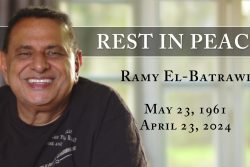Dear Editor,
In a commentary aired in January 2004 I said this: “During the years [1966 to 1976] the average rainfall per annum was 132.45 inches; the past 10 years [1993-2003] produced an average [rainfall] of less than 75 inches per year and everyone went to sleep in complacency, and this included the chairman of the D&I Board, the Permanent Secretary Ministry of Agriculture and the government.” In one of those years, 1967, according to the research in my commentary, we received an incredible 167 inches of rainfall. (All the rainfall data I am using were recorded at Plantation Houston Estate, EBD.) Despite all we are seeing now, in no year since 2004 did we receive more than 120 inches of rainfall in Demerara.
In 2004 I said that, “today we are flooding after only a small shower; my question is what happened to the drainage system which took off that 132.45 inches per annum during the period 1966 to 1976, and in the mid-eighties?” I said this one year before the great flood in January 2005.
“I will tell you what happened to it: incompetence, victimisation and corruption destroyed it. All of the historical data we have tell us that the area which will receive this high rainfall and which has the lowest land level on the Guyana coast is Region 4; that’s why the Demerara Estates are not as efficient as the Berbice ones. It all has to do with drainage and rainfall, and in numerous instances I have shown you how Region 4 has been starved for money by the PPP’s budget, given its population and its situation on the coast to maintain its infrastructure.”
The PPP and its board at GuySuCo, since not one member of the opposition is allowed to sit on this board, keeps telling us that all of this poor performance is due to climate change and the unusually heavy rainfall that is accompanying it, and I kept saying that this is a distortion of the facts, since my experience in sugar tells me that for Guyana this is normal. Mr Rashleigh Jackson always says, “that you are entitled to your own opinion, but you are not entitled to your own facts.” The facts are that there is no evidence that this country has to this date, as far as rainfall is concerned, experienced an effect which is abnormal and can be blamed on climate change; it is just another way for the PPP to obscure their incompetence by telling us lies.
In my commentary I also said this: “I don’t need to pay any British company to tell me [that] during the period of 1992 to 2003 this country received less than its traditional average of rainfall but that the drains that were existing prior to 1992 had to be maintained at those dimensions, since every 12 years or so this country receives alternating high/low rainfall patterns.”
Recently my friend Mr Earl John uncovered a speech on the sugar industry in Guyana, delivered by then Chairman of Booker McConnell Ltd, George S Bishop, at a luncheon meeting of the Sugar Club held on Friday, December 8, 1972, at the Downtown Athletic Club New York City.
Clearly I cannot go into the entire speech of 7 pages, but the first thing that strikes you as you read it is that in 1972 the population of Guyana was 750,000 almost the same as it is today! The second is that in 1971 we produced a record 369,000 long tons. And that (and I quote Mr Bishop here) “this year [1972] alas, production will amount to only 315,000 tons, mainly because of the exceptionally bad weather ‒ 150 inches of rainfall in 12 months.” In other words, in a year when we received 150 inches of rainfall in 12 months they produced nearly 100,000 tonnes more than we did in 2013!
Red flags should have been flying at full mast in 2006 that our sugar industry was in trouble, but politicians who had no experience in sugar, led by Mr Jagdeo, were setting up to expand our sugar industry at a time when everyone else was contracting theirs due to the withdrawal of the European Union’s subsidy, and in our case we were producing by 2006 only 246,332 tonnes, when in 1971 we produced nearly 370,000 tons. So clearly not only were we losing the subsidy, we were well on the way to becoming an uneconomical producer with a wage bill which was ruinous and with no possibility of proper mechanisation due to the peculiar layout of our fields and the excessively high rainfall common to this area below sea level.
Mr Bishop noted in his speech that the acreage under cane had increased from 68,000 acres in 1949 to 130,000 acres by 1972. The immediate phase of current expansion, he said, was aimed at lifting production to 400,000 tons by planting an additional 5,000 acres in 1972. And he was going to do it by using the existing factories in Guyana at that time, and not by building an expensive white elephant at Skeldon.
Mr Bishop sums it up well when he told the sugar people assembled in New York that “this extremely high rainfall [is] compounded by the fact that Guyana is the only country which grows sugar cane below sea level which makes growing sugar cane in Guyana very challenging; our sugar cultivation of 130,000 acres contains 5000 miles of drainage and irrigation canals.” He specifically referred to the difficulty of draining it.
Finally Mr Bishop told the gathering that the Guyana sugar-cane worker is the highest paid in the English-speaking Caribbean and that despite the glamour of nationalisation which the politicians tell the workers they will benefit from, “our experience throughout the world convinces us that large companies can work harmoniously and profitably with governments of developing nations and satisfy their aspirations without abandoning all the expertise, management and marketing skills which a big company brings to a young nation.” His words were very prophetic given the industry’s situation today, run by a board of political hacks who do not understand the industry, rather than professionals who understand the industry and its challenges, and the fact that their biggest asset is their workers. This PPP board deliberately reduced the workforce of GuySuCo from 28,000 in 1992 to 16,000 today, and still wants to know why they have a shortage of labour in the industry.
At that time Mr Bishop said that the government takes 55% of the profits in company taxation, and in addition to ensure the welfare of the workers, a profit-sharing scheme had been developed once the industry had made a return equivalent to 10% of its historical book value of its assets, 60 % of the extra profits going to the workers. Today we have to subsidise it from the Consolidated Fund which is fuelled by the taxes of all Guyanese.
Bishop then told those gathered in NY that wages had been rising steadily for many years and the average Guyanese sugar worker is now one of the best paid agricultural workers in the Common-wealth Caribbean. The improvement in standards of health he said was a very important concern to the sugar industry. The sugar producers he said ran an efficient medical service which provides free medical care to sugar workers and their families. The housing of the workers had also improved spectacularly – a large and increasing number of sugar workers and their families now lived in their own homes, paid for by interest free loans from the sugar Industry Labour Welfare Fund. There were steadily improving programmes for protection against injury, illness, retrenchment and old age, all of this had been done in line with industry policy and in close cooperation with government and sometimes international agencies. “We will never [he said] allow our investment in human resources to lag behind our investment in plant and materials.”
He told them that for 20 years under the leadership of Lord Campbell they had been working to accelerate the development and promotion of talented Guyanese for every level of management and technical control. Guyanese have been given university scholarships to attend British, Canadian and Caribbean universities and that the “The success of the Guyanese has been particularly striking. 90% of our management team in Georgetown is now Guyanese compared with 30% only 16 years ago.”
Put this in context with the most recent GuySuyCo’s development plan 2013-2018 which tells us that everywhere in the industry poorly trained managers abound.
Yours faithfully,
Tony Vieira





